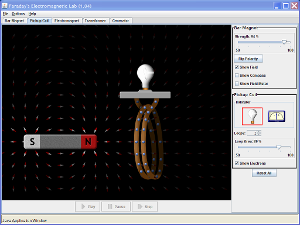←
(nm04)電磁感應 Electromagnetic Induction (I)
→
Pre-Amble: The Problem...
I≠f(t) → B≠f(t) but B≠f(t) → I≠f(t) doesn't happen
Pre-Amble: Michael Faraday (22 September 1791 – 25 August 1867)

Born in England, Michael Faraday (22 September 1791 – 25 August 1867) contributed to the fields of electromagnetism and electrochemistry. He is one of history's most influential scientists and engineers. Since he was born in a poor family, he received little formal education. He educated himself by reading books.
Father of Nanoscience and Nanotechnology. In 1847 he discovered that the optical properties of gold colloids (now called gold nanoparticles) differed from those of the corresponding bulk metal. This was the first reported observation of the effects of quantum size.
He was asked by the Prime Minister of England "What useful is electricity?" Faraday replied, "Why, Sir, there is every possibility that you will soon be able to tax it!"
His strong faith in Jesus influenced his life strongly. When offered a knighthood, he refused. He believed it was against Biblical teaching to accumulate riches and pursue worldly reward. When asked by the British government to advise on the production of chemical weapons, he likewise refused.
Key Points
| Flux Φ
| $$ \Phi_E = \iint \mathbf {\vec E} \, \cdot d \mathbf {\vec A} $$
| $$ \Phi_M = \iint \mathbf {\vec B} \, \cdot d \mathbf {\vec A} $$
|
|
| $$ \mathscr E \,\,\, (emf)$$ | $$ \mathscr E = W_{chem} / q \, \, (電池) $$
| $$ \mathscr E = - { {d \Phi_m} \over {dt}} $$
|
|---|
|

Faraday 法拉第 | $$ \mathscr E = \oint \color{fuchsia} {\mathbf {\vec E}}(t) \, \cdot \, d \, \mathbf {\vec s} = - { {d \Phi_m} \over {dt}} = - {d \over dt} \iint \color{fuchsia} { \mathbf {\vec B}}(t) \, \cdot d \mathbf {\vec A}(t)$$
|
|---|
|
目前電場和磁場是一个方便的数学方法,
现在是物理學
Up to this point, fields have been useful mathematical tools to help us do calculations,
Faraday discovered that these fields really do physically exist. (This idea was rejected by his fellow scientists. Faraday did not live to see the eventual acceptance of this idea by the scientific community.)
|
Selected Problems on Magnetism
29.60 An electron in a cathode-ray tube is accelerated through ΔV=10 kV. It then passes through a d=2.0-cm wide region of uniform B-field. What B-field strength will deflect the electron by θ=10.0 degrees?
29.30 Build a cyclotron that will accelerate protons to 10% of the speed of light (c). The largest vacuum chamber you can find is 44 cm in diameter. What B-field strength do you need?
103-2 Finish Previous PPT
103-2 (fr 32-100); 106-2 (fr 29-128) (108-2 Skip End Previous Chapter)
PPT: Knight Chapter 30

